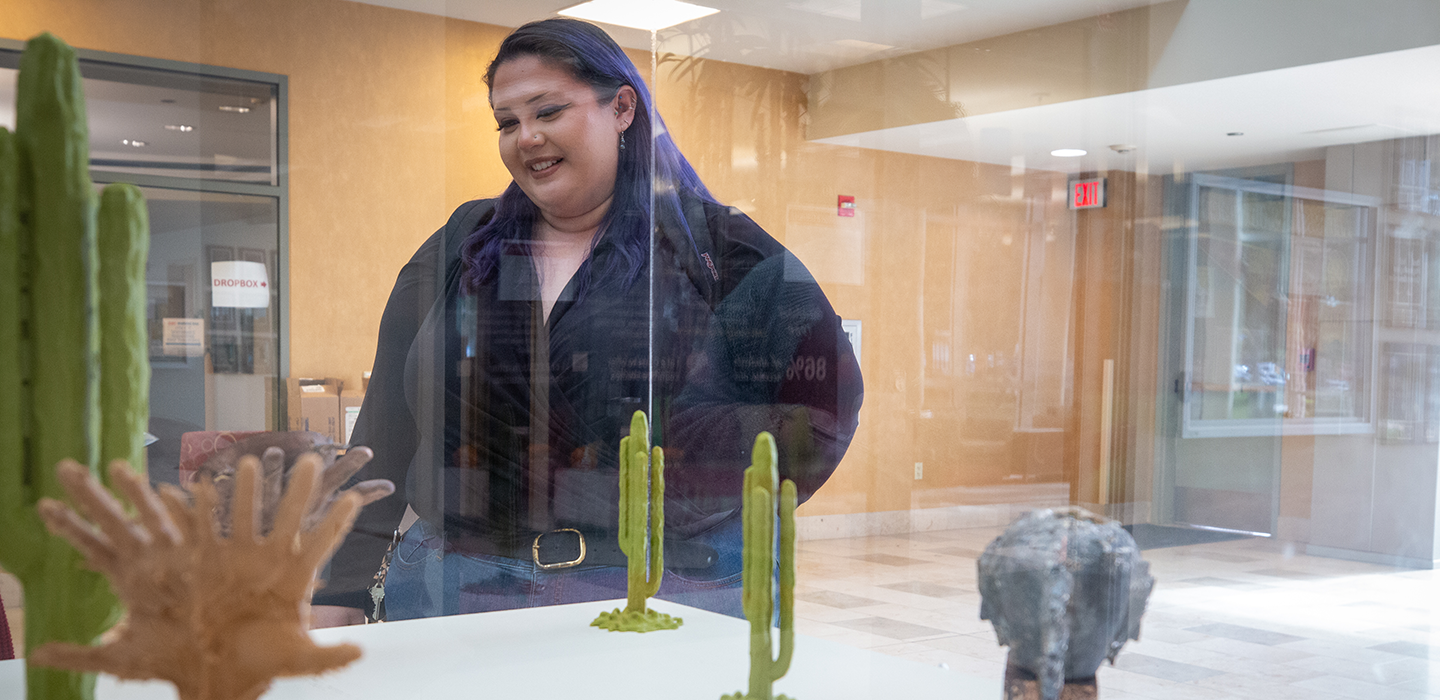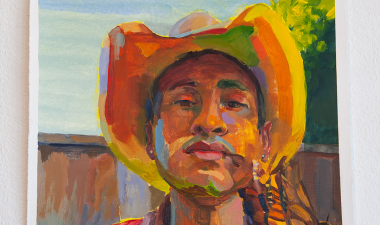The likeness of green Saguaro cacti in the display cases on the ground floor of Stanislaus State’s Mary Stuart Rogers Building draws in visitors who have ever visited Tucson or Mexico where they grow.
The metal sculptures are the work of fifth-year Bachelor of Fine Arts and Sociology major Melissa Parga, and they tell a bigger story.
The four cases hold “Internal Desertification,” Parga’s first solo art show and a revealing invitation into her personal journey.
The Saguaro represents humans, “soft and squishy, but we’re told to have a tough exterior and not back down and be a certain way,” Parga said. “These little spines are sticking out of you, and it’s a beautiful form.”
Other bronze pieces, cast in the Art Department’s Foundry and Metal Working Room, depict the faces and hands of white men, which represent the oppression of women.
“I combine multiple social constructs, such as classism, religion, racism, patriarchal standards, and how they intersect and influence individuals' development,” she wrote in her artist statement. “Ultimately, I am exploring adaptability in challenging environments and the quest for a sense of belonging and acceptance.”
Parga is particularly focused on the challenges of women, and for her, being young and Hispanic. Those themes and religion recur in the exhibit, a heavy topic because of its strong influence on so many lives.
She further connects the changes in herself and the world with the transformation of an idea into metal sculpture.
The result is an eye-catching display of varied forms. Parga included examples of her 3D printing processes and how it is used in metal casting. The white models, created by a 3D printer are not unlike something that could be made in the Dr. Allan Greenberg & Dr. Ellen Junn Warrior Fab Lab, where she is one of two student coordinators.
“One of the things she’s been pushing is using more technology with 3D modeling and 3D printing,” said Parga’s sculpture instructor and the Fab Lab’s founding Director Jacob Weigel. “Everything in the display cases was modeled on a computer first. Some are 3D printed. Some are cast in bronze, which is one of the oldest, traditional mediums in sculpture. What's interesting is finding new ways to create old techniques.”
In addition to melding new technology with ancient art forms, Parga is accomplished in other traditional mediums. One piece in the exhibit is an intaglio print of a woman lying on spikes, with clear references to religion. This continuous theme reflects her own struggle with the faith in which she was raised.
“She has a mixed-media emphasis,” Weigel said. “She does drawings and printmaking as well. She’s able to take a complex idea and explore it in different ways.”
-Melissa Parga, Student Artist
All went into a show of which she is proud.
“That’s all my hard work,” Parga said. “I’m happy people are able to see it. I spent so much of my time in the studio last semester. I was in class and working 20 hours a week in the lab. It was a very stressful semester, but I wouldn’t change it. I hope they see all the hard work that goes into it.”
The work was done in the spring and resulted in eight metal pieces.
Normally, a student completes three to five pieces in a semester, Parga said, but she was driven. Once the idea came to her, her days lasted from 9 a.m. to 11 p.m., but she has no regrets.
The result is an exhibit in a place where solo student art shows seem rare.
“I would say solo student exhibits account for about a quarter of the exhibitions,” said Steven Drouin, associate professor of advanced studies in education and the coordinator of the exhibits. “The purpose of the MSR Exhibition space is to give voice to faculty, students and staff on campus. I would love to showcase more student work, work by faculty and/or programs/groups on campus.”
The process involves submitting a proposal via email to Drouin and being approved by a committee.
Parga was encouraged to submit a proposal by Virgina Montero Hernandez, director of the Doctor of Education in Educational Leadership (EdD) program, who saw it when the two connected at a summer STEM program.
Parga wrote the proposal and had several faculty members read it and critique the pieces before submitting it.
The ability to formulate a show, she said, came from her Critical Concepts course, which teaches artists how to create a body of work that aligns with their ideas. It also taught her to receive direct critical input from art instructors who provide varied perspectives and viewpoints.
Though the Central Valley native arrived at Stan State as a first-generation student with plans of majoring in art with an emphasis on painting and drawing, she switched to mixed media after her first upper-division sculpture and print making courses.
“I love the laborious process behind it,” Parga said. “It makes you appreciate the work you put into it. It’s not immediate. It’s really the steps it takes. I fell in love with the Foundry. We have a foundry here, and when it’s up and running, it is so loud and super scary. You’re next to such a dangerous material as molten bronze, and later you pull out this one cast you spent weeks, maybe months on, and here she is, she’s born.”




